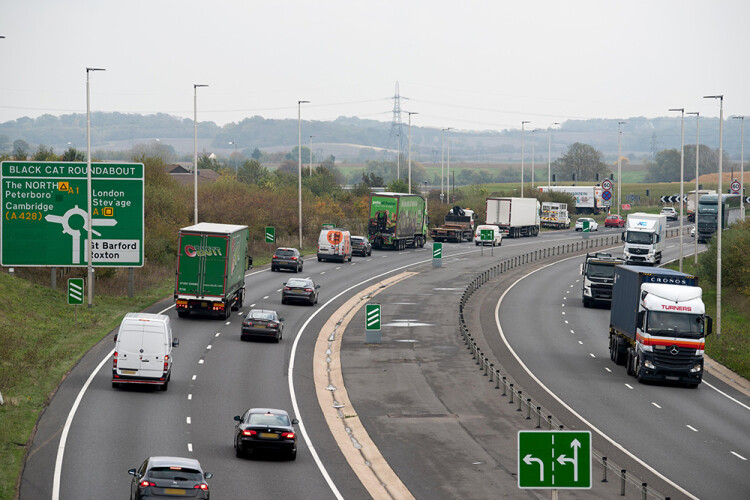As the country tries to steer itself away from the clutches of the coronavirus pandemic and its impact on the economy, it is clear that our transport infrastructure will play an important role in getting the UK’s recovery back on course.
With a road network of more than 250,000 miles, the UK is reliant on the safety and quality of its highway infrastructure to maintain social mobility and economic activity.
Good transport connectivity has proven invaluable in the past in helping ease the pain of fluctuating economic performance and will doubtless do so again – but only through an efficient transport network that delivers that connectivity and stimulates sustainable growth.
Undoubtedly the UK’s highways will play an intrinsic part in providing that. Currently the efficient movement of people and freight around the country and beyond is dependent on our roads, a focus that is unlikely to change anytime soon.
Existing committed government spend under the second period of its Road Investment Strategy (RIS2) stands at £24bn to be delivered between 2020 and 2025 – a significant increase over the £15bn seen over the 2015-20 RIS1 timeline – and now the government has unveiled its latest round of potential road projects in the spending pipeline. Through delivery body National Highways, it has pledged a further £350m to the development of schemes which, once their viability is proven, will be delivered through the RIS3 2025-30 spending period.
Local authorities are also committing spend to the highways sector. The local highways maintenance market for example has seen significant growth, driven by pothole repair funding in addition to cash allocated locally to transform towns and cities through improved public realm and active transport facilities. Demand by developers for increased levels of infrastructure to support electric vehicle charging and mass transit systems is also adding to the roads scope.
But it is the RIS project pipeline that provides the bulk of the investment into the strategic road network and there are currently 32 schemes vying for the all-clear to go through to the RIS3 funding period. Scattered across the UK these include the Severn Resilience Package – a raft of congestion-tackling improvements to parts of the M4, M5 and M32 motorways around Bristol – and plans to provide a minimum of three lanes in both directions along the A1 in Yorkshire between Doncaster and Dinnington.
National Highways has promised to work closely with transport passengers and road user groups as well as to consult widely with stakeholders and customers in a bid to make sure its RIS3 investment is focused on the right projects.
Already the Office of Rail and Road (ORR) has said it will beef up its scrutiny of those potential RIS3 projects in a move that it hopes will promote their efficient delivery.
The ORR’s remit is to advise government on whether a proposed RIS programme of investment is ‘challenging and deliverable’. It looks at the costs of projects, anticipated timescales and scheduling, and, by scrutinising plans, provides government with a greater level of assurance that National Highways can deliver the RIS efficiently and cost-effectively.
By announcing greater scrutiny over RIS3 projects the ORR is in essence planning to focus on the work that National Highways has achieved over the RIS1 (2015-20) and RIS2 (2020-25) periods and ensure that it is applying evidence and learning from those investment periods to RIS3.

This will include a greater focus on maintaining and renewing the network, enhancement projects and the environmental and safety targets that ORR expects National Highways to achieve.
RIS2 has already been revised due to projects being delayed during the planning phase and the government’s decision to pause the roll-out of its controversial ‘Smart Motorways’ programme. Sneha Patel, deputy director of highways at the ORR, says her approach to RIS3 will place greater emphasis on project-level reviews and the risks attached to specific projects and this will ultimately lead to better results for the public using the strategic road network.
She says: “Our work helps ensure government achieves the best value from its strategic road network investments. National Highways must provide sufficient detail to enable us to assure government that it can deliver in an efficient manner and it must provide a robust basis against which we can monitor its performance. Our oversight and scrutiny will lead to better outcomes for all those that use and are affected by the strategic road network.”
Those RIS2 projects that are currently going through the delivery process have progressed through a system that requires all stakeholders to be at the top of their game.

International construction and property consultant Rider Levett Bucknall (RLB) has provided its project management and risk assessment services to a range of clients including National Highways, local authorities and developers. According to Andrew Stamps, national head of infrastructure at RLB, efficiency, sustainability and safety are the common priorities across the client list.
He says: “Safety is always the prime consideration but there is no doubt that there is a drive for every project to be as cost effective as possible. The UK’s net zero 2050 goal is also an influence.”
Stamps is an advocate of drawing in new technologies and methods of working to help infrastructure projects deliver ‘more for less’. He claims that by encouraging innovation throughout the design, delivery and maintenance processes and challenging the norm, efficiencies and improvements can be better delivered.
“It is often the SMEs and start-ups that offer the greatest levels of innovation but they can find it difficult to get their ideas introduced,” he says. “We like to help them bring those ideas to the market.”
Key for contractors is to get boots on the ground and although there is a host of RIS2 schemes underway or nearing their construction stages, there are one or two notable projects that have been delayed through the planning process and beyond.

The rollout of the government’s Smart Motorways programme has stalled while safety concerns over their operation are investigated further. And the proposed construction of a dual carriageway and tunnel bypassing Stonehenge in Wiltshire, as well as junction improvements at the ancient monument’s eastern and western boundaries, has had its development consent order (DCO) quashed.
Despite the ongoing delays, National Highways has announced the More joint venture – a tie-up between Spanish firm FCC Construccion, Italian contractor Webuild and Austrian company BeMo – as its preferred bidder for the £1.25bn tunnel and main construction contract.
Also facing more time on the hard-shoulder is the Lower Thames Crossing, an £8bn new motorway connecting Kent and Essex through a tunnel beneath the River Thames.
It was initially intended that National Highways would apply for the DCO for the latest incarnation of this long-deliberated project late last year but a further consultation on a change of proposals has delayed that application. With the latest consultation not closing until the end of June, the DCO application will be delayed until later this year, despite bidders being shortlisted and a planned construction start date in 2024.
Other major RIS2 schemes include the £1.3bn A66 Northern Trans-Pennine Project, the DCO application for which is expected this year with a 2024 construction start date, and the £1.25bn A12 Chelmsford-A120 widening scheme which is also going through the consultation process and is expected to start on site in 2023/24.
There is also the £950m A428 Black Cat to Caxton Gibbet scheme between Bedfordshire and Cambridgeshire, which is timetabled to start on site in 2022/23.
But there are plenty of projects already progressing the length and breadth of the country. These include work to prevent landslips on the A83 at the Rest and Be Thankful – the highest point on the road separating Glen Kinglas from Glen Croe in Scotland. In Wales there is the A465: Sections 5 and 6 – Dowlais Top to Hirwaun – the £590m ‘Heads of The Valleys Road’ renewal being carried out by joint venture company Future Valleys in South Wales.
Meanwhile in north-east England Costain has the £183m A1 Scotswood – North Brunton improvements.
The number and variety of new and proposed highways projects demonstrate the importance of providing a funding regime and project pipeline that enables these vital infrastructure projects to get built at all, says Alasdair Reisner, chief executive at industry body the Civil Engineering Contractors Association:
“Despite several high-profile projects stalling, the RIS programme is proving essential in the delivery of major infrastructure schemes. The civil engineering sector thrives on certainty and with a pipeline of investment in place the industry gets that. It gives firms time to ensure they have the skills and competency to deliver that workload,” says Reisner.
Got a story? Email news@theconstructionindex.co.uk



